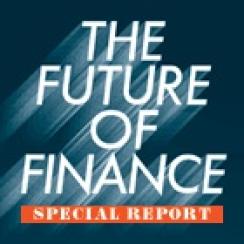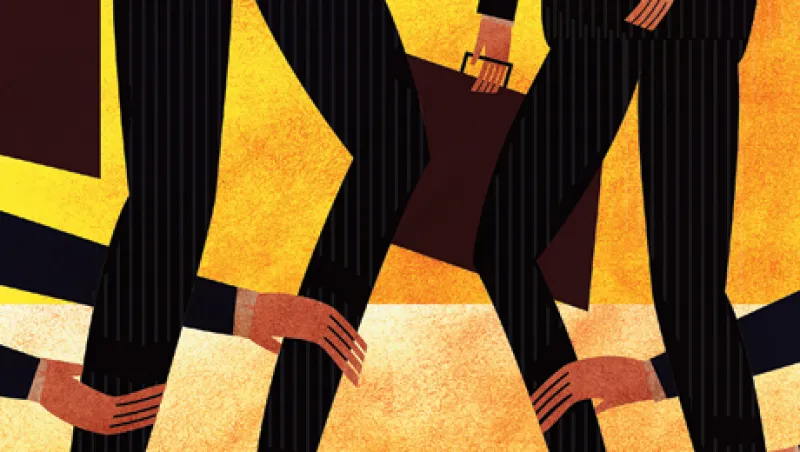
A modern-day Glass-Steagall remains a long shot, but Weill’s conversion nevertheless betokens a sea change in the prospects of an industry that defined a generation of debt-charged capitalism. Five years after the outbreak of the financial crisis, investments banks are facing a battery of profit-slashing structural changes, including sharply higher capital requirements under the Basel III Accord, a raft of new U.S. regulatory restrictions in the Dodd-Frank Wall Street Reform and Consumer Protection Act and a proposal from the U.K’s Independent Commission on Banking for new barriers between retail and investment banking.
The constraints may not stop there. A recent series of scandals and missteps — including bank manipulation of the benchmark London interbank offered rate, hefty fines for money laundering and sanctions busting by banks such as Barclays and HSBC Holdings, and a nearly $6 billion loss on massive credit hedges by JPMorgan Chase & Co. — have sparked fresh outrage. U.K. Prime

These days, few investment bankers hold out hope of returning to a favorable climate of light-touch regulation and soaring growth. Instead, banks will have to accept a diminished role, with business models designed for a less-leveraged and less-profitable environment.
“The proposed regulations will accelerate the return of banking to its core activities — financing, intermediation of risk and advice,” says Suneel Kamlani, the Stamford, Connecticut–based Deputy CEO of Royal Bank of Scotland’s Markets & International Banking business and a former COO of UBS Investment Bank. What that means for companies’ ability to raise capital — and with it, the larger economy — is difficult to gauge at this point, but some experts say it’s likely to raise corporate financing costs.
Only five years ago, Wall Street investment banks were at their zenith. Global investment banking revenues reached a record €310 billion ($387 billion) in 2007, according to research by Roland Berger Strategy Consultants . The industry fostered an elite culture, paying vast salaries to lure the most able graduates and maintaining close links to the corridors of political power. Goldman Sachs, the most successful investment bank, made record profits of $11.6 billion in 2007 and boasted a return on equity of 32 percent. That year it paid its employees an average of over $660,000 each and awarded $68.5 million in cash and shares — a record for any Wall Street CEO — to chairman and CEO Lloyd Blankfein. This was at a time when, according to the U.S. Bureau of Labor Statistics, the average surgeon earned $191,410 a year and the average lawyer took home $118,280.
Goldman’s former CEO Henry Paulson Jr. became U.S. Treasury Secretary in July 2006. The following year, JPMorgan hired former U.K. prime minister Tony Blair as an adviser, while his son Euan joined Morgan Stanley as an analyst. Investment banking seemed to represent the summit of the private sector, offering the most glittering prizes and prestige. Then came the collapses of Lehman Brothers Holdings and AIG, the hasty marriage of Bank of America and Merrill Lynch, the bailout of much of the U.S. banking industry under the controversial $700 billion Troubled Asset Relief Program and similar bailouts across most of Europe.
Some bankers acknowledge the industry has only itself to blame for its predicament. “It’s fair to say the investment banking industry lost sight of its core values,” says Colm Kelleher, co-president of Institutional Securities at Morgan Stanley in London and its head of Europe and Asia. “Risk models were flawed, compensation was too aligned with revenues as opposed to earnings, and in some cases banks were competing with their clients.”
Regulators tackled some of the excesses by imposing sharply higher capital and liquidity requirements under Basel III. That accord, which is being phased in through 2019, in combination with a subdued global economy is already having a dramatic impact. Aftertax returns on equity for the top 13 global investment banks will fall to an average of 7 percent from around 20 percent in the years on either side of the financial crisis, according to estimates by McKinsey & Co. — the result of a 25 percent decline in industry profits, from $40 billion in 2010, and a doubling of Tier 1 capital, to $400 billion.
The biggest driver of change is the new capital requirements for market and counterparty risk, which are more than double previous standards. These charges will put the hardest squeeze on the investment banks’ fixed-income, currencies and commodities businesses, which according to McKinsey have generated more than 50 percent of the banks’ revenues over the past five years.
“I would invest in a bank if I was sure it could achieve a 12 percent return on equity,” says Anik Sen, head of U.S. and European financials at asset manager PineBridge Investments in London. But even that much-reduced threshold looks beyond the grasp of most banks, primarily because of the continuing euro zone crisis. Some banks are registering small losses, notably UBS Investment Bank, which announced last November that it would scale back its ambitions and cut its risk-weighted assets by around 50 percent, to SFr135 billion ($141 billion), by 2016.
| Law of Diminishing Returns | ||||||||||||
| Impact of new regulations on banks' return on equity | ||||||||||||
| Businesses | Pre- regulation % | Market- risk framework | counter- party- credit risk | OTC shift: RWA1 reduction | OTC shift: revenue impact | capital ratio | leverage ratio | liquidity and funding costs | Post- regulation % | Change % | ||
| Foreign exchange | 30 | -8 | 0 | 0 | 0 | -4 | 0 | -2 | 16 | -45 | ||
| Flow rates | 19 | -6 | -5 | 4 | -1 | -2 | 0 | -1 | 8 | -60 | ||
| Structured rates | 15 | -4 | -6 | 1 | -1 | -1 | 0 | -1 | 4 | -80 | ||
| Flow credit | 18 | -8 | 0 | 0 | -1 | -1 | 0 | -1 | 6 | -65 | ||
| Structured credit | 17 | -9 | -2 | 1 | -1 | -1 | 0 | -1 | 3 | -85 | ||
| Commodities | 20 | -6 | -3 | 1 | -1 | -2 | 0 | -2 | 8 | -60 | ||
| Cash equities | 25 | -5 | 0 | 0 | 0 | -3 | 0 | -2 | 15 | -40 | ||
| Flow Equity Derivatives | 25 | -8 | -1 | 2 | -5 | -2 | 0 | -2 | 9 | -65 | ||
| Structured Equity Derivatives | 27 | -10 | -4 | 1 | -1 | -2 | 0 | -2 | 9 | -70 | ||
| Prime services | 15 | 0 | 0 | 0 | 0 | -3 | -3 | -1 | 8 | -45 | ||
| Proprietary trading | 35 | -22 | -1 | 0 | -1 | -2 | 0 | -2 | 7 | -80 | ||
| total capital markets | 20 | -7 | -3 | 2 | -1 | -2 | 0 | -1 | 7 | -65 | ||
| Source: McKinsey & Co. | |||||||||||
Yet banks are slow to take such action. While they have cut the absolute level of remuneration, with Goldman’s annualized average pay per employee standing at around $340,000 this year, down nearly 50 percent from 2007, compensation ratios typically remain in their long-standing range of 40 to 50 percent of revenues.
Goldman allocated 42 percent of revenues to compensation in 2011 — only two percentage points less than in 2007, while Morgan Stanley’s 2011 ratio was 52 percent, down from the 62 percent it paid out in the loss-making year of 2009. “They are still reluctant to slash and burn their businesses, because they believe there will be an upturn eventually,” says PineBridge’s Sen, formerly a longtime bank analyst at both Goldman Sachs and UBS.
DESPITE THE CUTS THAT HAVE TAKEN PLACE OVER the last year, head counts remain at historically high levels. Goldman employs around 32,500, some 2,000 more than it did in 2007. Morgan Stanley’s head count is now over 60,000, approximately 10,000 more than before the financial crisis, although much of the gain reflects the firm’s growing emphasis on brokerage and wealth management.
“The compensation payouts are ludicrous” in light of today’s lower profit margins, says Christopher Wheeler, an analyst at Mediobanca Securities in London. “There has to be a downscaling of expectations so that only small numbers at the top, as in any other industry, get big rewards.”
Morgan Stanley has been the most candid about the need to bring down pay, but how banks can achieve this without losing key talent remains uncertain. As Kelleher says, “It’s clear that compensation in the industry has to be reengineered, so the industry will lose people in this climate. And that’s probably no bad thing.”
In some cases, a smaller number of bankers are receiving multimillion-dollar pay awards. A senior London-based source at a large Wall Street bank says that in the mid-2000s the top 5 percent of professionals at his firm, around 1,000 people, were paid $1 million or more annually. Now, he says, “it’s more like the early ’90s, with just a handful earning that much.”
Says Huw Jenkins, a former CEO of UBS’s investment banking arm who is now a managing partner in the London office of Brazilian investment bank BTG Pactual, “It’s not sustainable that a banker should be paid 10 or 20 times what an experienced doctor is paid.” BTG Pactual has a compensation ratio in the 30 percent range.
It’s easy to forget that investment bankers were once run-of-the-mill executives. Compass’s Keevil, for instance, recalls joining Morgan Stanley’s corporate finance division in New York in 1975 as one of only 12 MBA graduate recruits globally, for a salary of $17,000 plus a 40 percent bonus — less than he was offered by some of the bigger management consultants.
For the time being, however, there are few signs of a reversion to the industry’s more-modest days. Harvard Business School employment statistics show that, for MBA classes of the past decade, investment banking remains the second most popular career after consulting. Generally, around 10 percent of graduates each year seek well-paid opportunities on Wall Street. At the University of Pennsylvania’s Wharton School, around a quarter of each class typically goes into the industry. Malcolm Horton, global head of recruitment at Nomura in London, says that his firm receives between 25,000 and 50,000 applications for 2,000 graduate-level jobs every year. But, he notes, “compensation will be lower in the years to come, and we are lowering our new hires’ expectations.”
Amid the pressures on the industry, many big banks are seeking to minimize cutbacks in hopes of being the last man standing. “Market pressures will force some of the weaker players to scale back or withdraw from certain areas of the market, allowing us to increase our market share,” says Rupert Hume-Kendall, chairman of global capital markets at Bank of America Merrill Lynch in London. Citigroup will continue to provide the same range of products as in precrisis times, though to a somewhat smaller range of large corporate clients, according to James Bardick, Citi’s London-based co-head of banking for Europe, the Middle East and Africa.
Still, many banks are making a marked retreat from such areas as proprietary trading and trade and project finance. There is also likely to be a significant withdrawal in the next few years from fixed-income, currencies and commodities trading. So far, this doesn’t look like particularly bad news for corporations and the global economy; there is considerable overcapacity in the industry, and alternative firms and investors are willing to step in. Roland Berger’s Böhme asserts that the shadow banking system, including hedge funds and private equity firms, could pick up perhaps a third of the risk-taking capacity that banks are shedding.
Banks are phasing out their prop trading arms in response to the Volcker rule, the U.S. regulation that severely restricts banks from trading on their own account. Although prop trading now represents only about 5 percent of total investment banking revenues for the 13 largest banks, according to McKinsey, before the financial crisis it accounted for around half of Goldman’s revenues and a quarter of Morgan Stanley’s. Traders have already begun moving to hedge funds, and Goldman has been winding down its operations since 2010. The bank has been shrinking its prop trading arm, its investing and lending division, which represented only 3 percent of group revenues in the second quarter. Mediobanca’s Chris Wheeler believes Goldman will eventually spin off the division. Morgan Stanley closed down its prop trading unit last year.
Project and trade finance are also becoming less attractive as Basel III effectively penalizes long-term debt by requiring banks to more closely match the duration of their assets and liabilities. Dealogic data shows that project finance deals this year are lagging behind those of 2011, with only $29.3 billion of deals announced globally by mid-August, compared with $79 billion for all of 2011. But asset managers, private equity firms and other funds are set to take up the slack, according to Régis Monfront, deputy chief executive of corporate and investment banking at Crédit Agricole in Paris. His bank will launch a new financing model later this year that will enable it to sell 80 percent of its corporate loans to partners — mainly Asian asset managers and funds. Previously, the bank has syndicated loans only with other banks.
Fixed-income trading is a core, usually profitable activity for investment banks, but it’s not something they will be able to do on the same scale for much longer, given the new capital requirements. Perhaps a third of today’s total FICC revenue could shift to hedge funds and other alternative investors over the next few years, forecasts Roland Berger’s Böhme. Frédéric Janbon, global head of fixed income at BNP Paribas in London, sees global players falling from today’s 15 or so to as few as ten.
Initiatives to pick up this business are at an early stage, but it’s not only alternative-asset managers who see opportunities. New York–based BlackRock, which manages $1.2 trillion of fixed-income assets, has set up a trading platform, Aladdin Trading Network, within its BlackRock Solutions risk and advisory services unit.
New players won’t be able to replace the role of banks in these markets, though. “A certain amount of trading could be hived off or taken up by other firms, but not much financing,” says Mike Rees, head of wholesale banking and a board member at Standard Chartered Bank. “Companies will want banks to do things like underwriting issues,” he notes, asserting that companies prefer banks to perform that role because they are more closely regulated than other potential conduits of capital. Shawn Matthews, CEO of Cantor Fitzgerald & Co. in New York, predicts that the role of asset managers and funds will be limited to holding assets, while the banks will act as intermediaries, matching up buyers and sellers and holding assets over short periods to make markets.
Overall, such changes could make it more expensive for companies to raise capital, as banks are likely to pass along at least part of their increased costs. Roland Berger estimates that, as a result of all the regulatory changes, fixed-income underwriting fees will rise by 10 percent.
The new regulatory environment does have some silver lining for investment banks. Jean-Laurent Bonnafé, CEO of BNP Paribas, argues that capital markets in Europe will become more important as banks are forced to cut back on lending. European companies currently raise only about 25 to 30 percent of their financing in the capital markets there, with banks supplying the rest, roughly the reverse of proportions in the U.S. “There is plenty of potential to expand our already strong fixed-income capabilities,” Bonnafé says.
Banks can’t be easily replaced anywhere. “It’s difficult to see what other kinds of institutions could sustain such large, liquid bond markets — we need the flow monsters like J.P. Morgan and Deutsche Bank,” says Mediobanca’s Wheeler. The global corporate bond market is vast, even after having come well down from its peak of $3.3 trillion of issuance in 2009, according to Standard & Poor’s data. In 2011 it was still as high as $2.44 trillion, and in the first half of 2012, $1.4 trillion of corporate bonds were issued.
Morgan Stanley’s Kelleher is confident the banks will still control the capital markets. “I don’t buy the argument that the investment banking industry is in secular decline,” he says, adding that demographics and reduced public sector provision mean that private sector pensions and savings will continue to drive liquidity in the capital markets. According to TheCityUK, a financial services industry body in London, global pension assets stood at $30.9 trillion at the end of 2011, double the level of a decade earlier.
Yet the threat of more draconian regulation still exists. In an interview with Institutional Investor, the FDIC’s Hoenig, a former president of the Federal Reserve Bank of Kansas City, argued that banks’ activities should be severely restricted to minimize risks to depositors and taxpayers. He has been actively lobbying politicians on Capitol Hill, and his argument has gained momentum since the Libor scandal broke in June. Hoenig proposes that deposit-taking banks not be allowed to conduct broker-dealer activities, trade securities or derivatives for either their own account or customers’, or sponsor hedge or private equity funds. That would leave them conducting the less risky activities associated with investment banks, such as M&A advisory, securities underwriting, and wealth and asset management. “There’s too much risk concentrated in these institutions, so we want to force the broker-dealer out,” Hoenig says.
Hoenig’s campaign may not succeed, but the investment banking industry is being cut down to size nonetheless. • •







